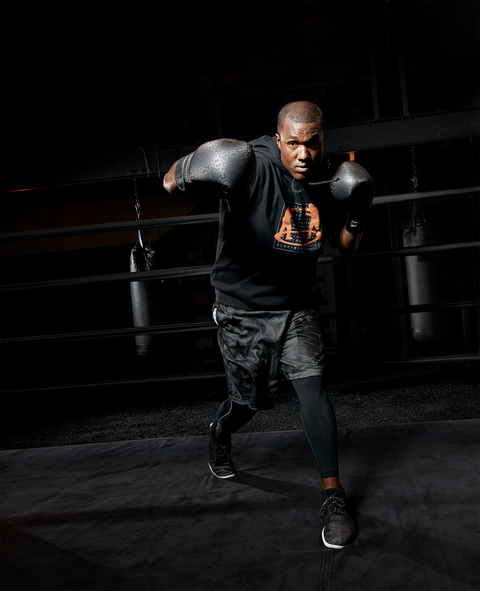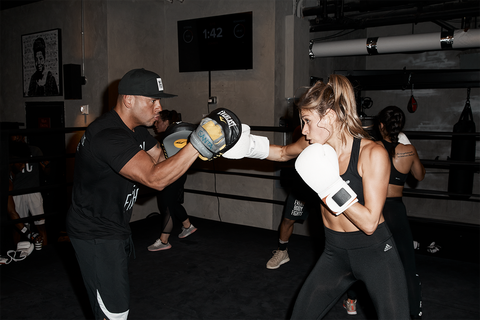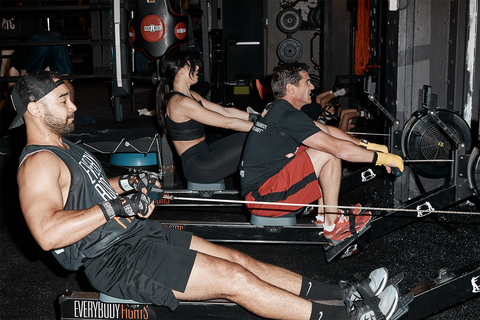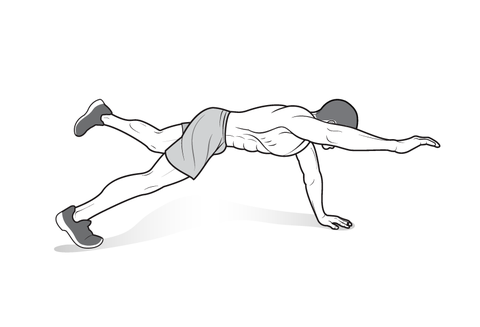
I’m approaching the end of round 10 in a 15-round gauntlet of a workout class. My trainer, George Foreman III, yells, “Go hard! Unleash fury!” and for the next 30 seconds, all of us whale away on heavy bags, delivering hook after slamming hook.

ALLIE HOLLOWAY
It’s the Trainx360 class at EverybodyFights in Manhattan, and the lessons are clear for the 50-50 mix of about 30 men and women in attendance. First, punching something with all your might feels great. Second, it’s hellishly tiring. When the bell rings, forget rest: I hit the floor, boxing gloves still on, and hold a plank.
A New Way to Get Fighting Fit
From Rumble to Shadowbox, boxing-inspired group workouts are gaining popularity as people seek new ways to burn fat, build muscle, and learn self-defense. But no gym aims to do it like EverybodyFights, the Boston-based boxing club that’s storming along the East Coast with plans to expand to California, Kentucky, Texas, and Washington, D. C.
At EverybodyFights, you’re training the way Foreman, the son of legendary “Big George” and the creator of EverybodyFights, once did. Most group boxing classes blend bag work with calisthenics to spike your heart rate. This gym pushes you through fat-blasting old-school boxing drills, then uses other gym tools to hone your boxing technique.
Sure, you work heavy bags, speed bags, and punch machines, and you spar in the ring. But you also battle Airdyne fan bikes, rowing machines, and kettlebells. You’re ruled by the clock, fighting through three-minute rounds, just like a boxer.
It’s all drawn from the training Foreman himself endured. Back in 2006, with Big George as his coach, he took up boxing in an effort to lose weight. For four years, he trained under his father, pummeling his way to a 16–0 record (with 15 KOs).
But the more father and son worked together, the more tension built between them. In 2013, Foreman decided to “take a break” from the sport. “I wasn’t getting a dad, and he wasn’t getting a son,” says Foreman, now 35.
But G-3 wanted to stay fight-ready, so he built a gym for himself in Boston, where he’d gone to school, making sure it had what he needed to stay in fighting shape. Planning his return to fighting, he trained circuit-style, going from rower to Airdyne to kettlebells to suspension trainers to ring work, finishing with core work. When his gym opened to the public, the boxing and circuit-training areas were underutilized, and a friend suggested he turn his own workouts into a group class called Trainx360, which is now his flagship class.
Mixing Up the Strikes
That’s not the only class here. Foreman learned the value of yoga when fighting, so EverybodyFights also offers a Flow class with meditation. There’s also an endurance- focused class with cycling, treadmill running, and rowing.

ALLIE HOLLOWAY
“Only 20 percent of what you do in our classes is actual boxing,” he says. It all lays the foundation you need to be a better boxer. Boxers do woodchopping drills to build core and leg power; in Trainx360, I slam medicine balls. I squat low to pick up kettlebells, then stand and hoist them to my chest, a lightweight version of the hay-bale flips Foreman did under his dad’s watch. Foreman once slammed mallets into a tire to hone hand speed; he has me whip battle ropes for the same reason.
Foreman keeps us moving, allowing just 15 seconds of rest between rounds. Twelve rounds in, partly because of how hard we hit the bags early on in the workout, I’m dripping sweat, my legs are jelly, and my shoulders are on fire.
That’s when Foreman cranks it up: The last three rounds offer no rest, all planks, pushups, and burpees. “Part of boxing,” he says, “is learning how to push through fatigue, extending your perceived limits, and working while you recover.” I’m not seeing the “recover” part.
Especially not during the final 30 seconds of the day, when I’m most gassed. That’s when Foreman shouts to go all-out one more time on the heavy bag. I throw a jab-jab-cross, fire back-to-back hooks, deke, then deliver another jab-cross. There’s something invigorating about recruiting all your strength to throw those final punches. This is different from banging out a final set of bench-press reps.
This makes me feel like a warrior.
Home Fight Club
Punch up your own workouts with some moves and wisdom from EverybodyFights.
Find your stance
Get both hands up, shoulders relaxed, chin down so it’s protected by your fist. If you’re right-handed, get your right foot behind your left, but keep your weight evenly distributed. You should be able to bounce back and forth between feet easily.
Push-pull to punch
The most important punch is the jab (a quick hit forward with your left hand if you’re a righty). The powerful right-handed cross follows. To make that right impactful, don’t just punch. As you’re pushing your right arm forward, rotate your right hip forward and actively pull your left hand and left hip back. Foreman uses the Airdyne to teach this to newcomers; when you pull one bike arm, you must push the other.
Pick your spots
Not every punch is meant to be your hardest, something you’ll figure out just minutes into any EverybodyFights class. Crush the bag with those right jabs, uppercuts, and crosses, but don’t be too aggressive with every punch, especially the jab; it’ll leave you off-balance and open to attack.
Draw your hand back as quickly as possible after you throw a punch, says George Foreman III of EverybodyFights.
BOOT-CAMP MOVES
1-2 burpee

Peter Sucheski
It’s a full-body workout and boxing practice all rolled into one. Get into your boxer’s stance; throw a left jab, then a right.

Peter Sucheski
Immediately do a burpee, dropping your chest to the ground, then standing back up; quickly get back into boxer’s stance. That’s 1 rep. At EverybodyFights, you’ll sometimes repeat this for 3 straight minutes.
Bird-dog plank

Peter Sucheski
The mechanics of a punch challenge your core to transfer energy from leg to opposite arm. Bird-dog planks mimic that, forcing your core to keep you balanced. Get in pushup position, then lift your right hand and left leg off the ground. Keep your hips stable. Hold, then repeat on the other side. That’s 1 rep; do reps for a minute.
Duck walk

Peter Sucheski
The finest boxers have strong legs that can endure even near the end of a fight, but they don’t just do squats. Try the duck walk: Squat until your thighs are parallel to the ground. Staying in this low position, walk forward 10 to 15 yards. Turn around and walk back. Do 3 sets. For a challenge, follow each set of duck walks with 20 seconds of jab-crosses.
Source: Read Full Article
